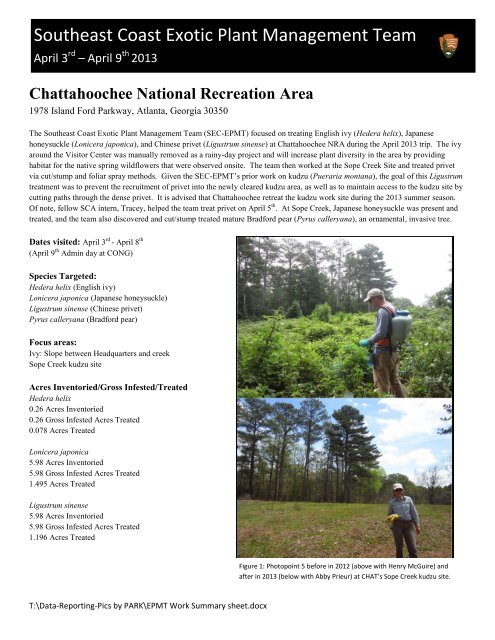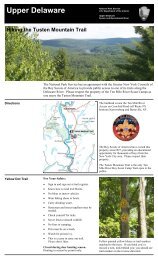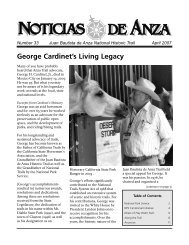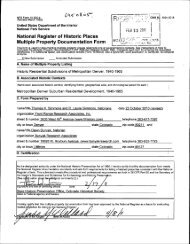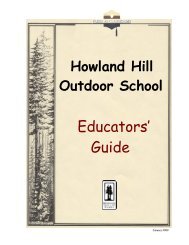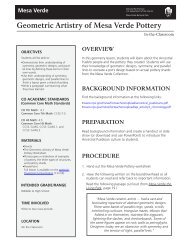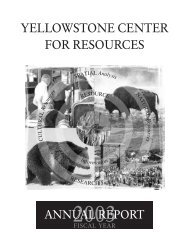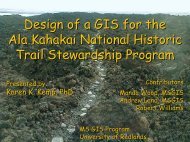Southeast Coast Exotic Plant Management Team - National Park ...
Southeast Coast Exotic Plant Management Team - National Park ...
Southeast Coast Exotic Plant Management Team - National Park ...
You also want an ePaper? Increase the reach of your titles
YUMPU automatically turns print PDFs into web optimized ePapers that Google loves.
<strong>Southeast</strong> <strong>Coast</strong> <strong>Exotic</strong> <strong>Plant</strong> <strong>Management</strong> <strong>Team</strong>April 3 rd – April 9 th 2013Chattahoochee <strong>National</strong> Recreation Area1978 Island Ford <strong>Park</strong>way, Atlanta, Georgia 30350The <strong>Southeast</strong> <strong>Coast</strong> <strong>Exotic</strong> <strong>Plant</strong> <strong>Management</strong> <strong>Team</strong> (SEC-EPMT) focused on treating English ivy (Hedera helix), Japanesehoneysuckle (Lonicera japonica), and Chinese privet (Ligustrum sinense) at Chattahoochee NRA during the April 2013 trip. The ivyaround the Visitor Center was manually removed as a rainy-day project and will increase plant diversity in the area by providinghabitat for the native spring wildflowers that were observed onsite. The team then worked at the Sope Creek Site and treated privetvia cut/stump and foliar spray methods. Given the SEC-EPMT’s prior work on kudzu (Pueraria montana), the goal of this Ligustrumtreatment was to prevent the recruitment of privet into the newly cleared kudzu area, as well as to maintain access to the kudzu site bycutting paths through the dense privet. It is advised that Chattahoochee retreat the kudzu work site during the 2013 summer season.Of note, fellow SCA intern, Tracey, helped the team treat privet on April 5 th . At Sope Creek, Japanese honeysuckle was present andtreated, and the team also discovered and cut/stump treated mature Bradford pear (Pyrus calleryana), an ornamental, invasive tree.Dates visited: April 3 rd - April 8 th(April 9 th Admin day at CONG)Species Targeted:Hedera helix (English ivy)Lonicera japonica (Japanese honeysuckle)Ligustrum sinense (Chinese privet)Pyrus calleryana (Bradford pear)Focus areas:Ivy: Slope between Headquarters and creekSope Creek kudzu siteAcres Inventoried/Gross Infested/TreatedHedera helix0.26 Acres Inventoried0.26 Gross Infested Acres Treated0.078 Acres TreatedLonicera japonica5.98 Acres Inventoried5.98 Gross Infested Acres Treated1.495 Acres TreatedLigustrum sinense5.98 Acres Inventoried5.98 Gross Infested Acres Treated1.196 Acres TreatedFigure 1: Photopoint 5 before in 2012 (above with Henry McGuire) andafter in 2013 (below with Abby Prieur) at CHAT’s Sope Creek kudzu site.T:\Data-Reporting-Pics by PARK\EPMT Work Summary sheet.docx
<strong>Southeast</strong> <strong>Coast</strong> <strong>Exotic</strong> <strong>Plant</strong> <strong>Management</strong> <strong>Team</strong>April 3 rd – April 9 th 2013Pyrus calleryana5.98 Acres Inventoried5.98 Gross Infested Acres Treated0.01 Acres Treated<strong>Team</strong> members:Abby PrieurChris SheldonDarrin GobbleAmorita Brackett (Field Crew Leader)Office phone: 803-647-3985Crew cell: 803-351-2756Equipment used:ChainsawBrushcutterBackpack sprayerHand sprayerArea hazards:TrippingPoison ivyYellow jacketsHerbicide Use:Figure 2: Chattahoochee and SEC-EPMT interns Tracey Brandt (above)and Darrin Gobble (below) before and after cut/stump treatment ofprivet at Sope Creek.NameGarlon3ARazorProRoundupProActiveIngredientTriclopyramineConcentration(%)TotalMixUsedVolume ofUndilutedHerbicideDiluentDyeand%25 3.25 L 0.81 L Water 0.5Glyphosate 3 78 L 2.34 L Water 0.5Glyphosate 3 112 L 3.36 L Water 0.5SpeciesLigustrum sinensePyrus calleryanaL. sinenseLonicera japonicaL. sinenseL. japonicaTreatmentCut/StumpFoliarFoliarNotes:The success of the ongoing kudzu treatments at Sope Creek is evident, as the biomass removal has resulted in high visitor foot andbike traffic through the area. Two social trails have appeared through the site since the summer 2012 treatment and the teamrecognizes that social trails in this area are an ongoing concern for Chattahoochee NRA. The presence blackberry (Rubus sp.) andnonnative rose bushes, likely the invasive multiflora rose (Rosa multiflora), have increased in the fields. If CHAT would identify therose species, it could be incorporated into the next Sope Creek treatment. Also, Japanese honeysuckle was abundant and should beconsidered in future treatment efforts. Yellow jacket nests and fire ant mounds were prevalent in the southern field of the treatmentsite. Lastly, the available housing and logistical support from Chattahoochee staff was greatly appreciated, as always!T:\Data-Reporting-Pics by PARK\EPMT Work Summary sheet.docx
<strong>Southeast</strong> <strong>Coast</strong> <strong>Exotic</strong> <strong>Plant</strong> <strong>Management</strong> <strong>Team</strong>April 3 rd – April 9 th 2013Additional Photos:Figure 3 : Southern field at Chattahoochee’s Sope Creek kudzu site and the emergence of social trails post-kudzu treatment (right).Figure 4: Photopoint 6 with SEC-EPMT crew members before in 2012 (left) and after in 2013 (right) at CHAT’s Sope Creek kudzu site.T:\Data-Reporting-Pics by PARK\EPMT Work Summary sheet.docx
<strong>Southeast</strong> <strong>Coast</strong> <strong>Exotic</strong> <strong>Plant</strong> <strong>Management</strong> <strong>Team</strong>April 3 rd – April 9 th 2013GLOSSARY OF TERMSInventoried AreaThe inventoried area is the total area covered by the <strong>Exotic</strong> <strong>Plant</strong> <strong>Management</strong> <strong>Team</strong> (EPMT) during the course of invasive plantmanagement/control activities. An area may be considered “inventoried” regardless of the presence/absence of target invasive plantspecies. The inventoried area is obtained by GPSing the perimeter, GPSing perimeter points, or digitizing the perimeter on screenusing landform references.Gross Infested AreaThe gross infested area is defined as the general perimeter of an infestation. Gross infested areas contain the target species and thespaces between these populations, colonies or individuals. A gross infested area is described by a polygon or a line feature (i.e.riparian course, roadway) which is buffered to account for the maximum distribution of individuals within the inventoried area.Infested AreaThe infested area is the actual area covered by the canopy of an invasive plant species within the gross infested area. The infested areadoes not include the spaces between individuals, colonies or populations of the target invasive plant species. The total infested areamay be comprised of multiple infested areas, which are defined by polygons, buffered points, buffered lines, or calculated from a stemcount in which each individual is assigned a coverage multiplier that was derived by monitoring.Treated AreaTreated area is defined as either the entire infested area if it was treated during the course of work conducted by the EPMT or a subsetof an infested area which has received treatment action(s). Treatment area is defined by polygons, buffered points, buffered lines, orcalculated from a stem count in which each individual is assigned a coverage multiplier.*All of these terms apply to single species measurements. When there is more than one invasive species in an area, the abovemeasurements need to be applied to each species (population) individually.T:\Data-Reporting-Pics by PARK\EPMT Work Summary sheet.docx


